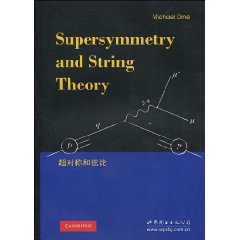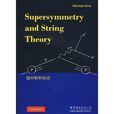《超對稱和弦論》是2009年8月1日世界圖書出版公司出版的圖書。本書適合超對稱和弦論的從業人員及相關人士使用。
基本介紹
- 書名:超對稱和弦論
- 又名:supersymmetry and string theory
- 作者:(美國)戴恩(MichaelDine)
- ISBN:9787510005138, 7510005132
- 頁數:515頁
- 出版社:世界圖書出版公司
- 出版時間:第1版 (2009年8月1日)
- 裝幀:平裝
- 開本:16
內容簡介,目錄,
內容簡介
《超對稱和弦論(英文版)》內容簡介:TheStandardModelhasreignedtriumphantforthreedecades.Forjustaslong,theoristsandexperimentalistshavespeculatedaboutwhatmightliebeyond.Manyofthesespeculationspointtoaparticularenergyscale,theteraelectronvolt(TeV)scalewhichwillbeprobedforthefirsttimeattheLHC.Thestimulusforthesestudiesarisesfromthemostmysterious-andstillmissing-pieceoftheStandardModel:theHiggsboson.Precisionelectroweakmeasurementsstronglysuggestthatthisparticleiselementary(inthatanystructureislikelyfarsmallerthanitsComptonwavelength),andthatitshouldbeinamassrangewhereitwillbediscoveredattheLHC.Buttheexistenceoffundamentalscalarsispuzzlinginquantumfieldtheory,andstronglysuggestsnewphysicsattheTeVscale.Amongthemostprominentproposalsforthisphysicsisahypotheticalnewsymmetryofnature,supersymmetry,whichisthefocusofmuchofthistext.Others,suchastechnicolor,andlargeorwarpedextradimensions,arealsotreatedhere.

目錄
Preface
A note on choice ofmetric
Text website
Part 1 Effective field theory:the Standard Model,supersymmetry,unification
1 Before the Standard Model
Suggested reading
2 The Standard Model
2.1 Yan9—Mills theory
2.2 Realizations of symmetry in quantum field theory
2.3 The quantization of Yan9—Mills theories
2.4 The particles and fields of the Standard Model
2.5 The gauge boson masses
2.6 Quark and lepton masses
Suggested reading
Exercises
3 Phenomenology of the Standard Model
3.1 The weak interactions
3.2The quark and lepton mass matrices
3.3 The strong interactions
3.4The renormalization group
3.5 Calculating the beta function
3.6The strong interactions and dimensional transmutation
3.7 Confinement and lattice gauge theory
3.8 Strong interaction processes at high momentum transfer.
Suggested reading
Exercises
4 The Standard Model as an effective field theory
4.1Lepton and baryon number violation’
4.2 Challenges for the Standard Model
4.3 The hierarchy problem
4.4Dark matter and dark energy
4.5 Summary:successes and limitations of the
Standard Model
Suggested reading
5 Anomalies,instantons and the strong CP problem
5.1 The chiral anomaly
5.2 A two-dimensional detour
5.3 Real QCD
5.4 The strong CP problem
5.5 Possible solutions of the strong CP problem
Suggested reading
Exercises
6 Grand unification
6.1 Cancellation of anomalies
6.2 Renormalization of couplings
6.3 Breaking to SU(3)×SU(2)×U(1)
6.4 SU(2)×U(1)breaking
6.5 Charge quantization and magnetic monopoles
6.6Proton decay
6.7 Other groups
Suggested reading
Exercises
7 Magnetic monopoles and solitons
7.1 Solitons in 1+1 dimensions
7.2 Solitons in 2+1 dimensions:strings or vortices
7.3 Magnetic monopoles
7.4 The BPS limit’
7.5 Collective coordinates for the monopole solution
7.6 The Witten effect:the electric charge in the presence of θ
7.7 Electric—magnetic duality
Suggested reading
Exercises
8 Technicolor:a first attempt to explain hierarchies
8.1 QCD in a world without Higgs fields
8.2 Fermion masses:extended technicolor
8.3 Precision electroweak measurements
Suggested reading
Exercises
Part 2 Supersymmetry
9 Supersymmetry
9.1 The supersymmetry algebra and its representations
9.2 Superspace
9.3 N —— 1 Lagrangians
9.4 The supersymmetry currents
9.5 The ground-state energy in globally supersymmetric theories
9.6 Some simple models
9.7 Non-renormalization theorems
9.8 Local supersymmetry: supergravity
Suggested reading
Exercises
10 A first look at supersymmetry breaking
10.1Spontaneous supersymmetry breaking
10.2The goldstino theorem
10.3Loop corrections and the vacuum degeneracy
10.4Explicit, soft supersymmetry breaking
10.5Supersymmetry breaking in supergravity models
Suggested reading
Exercises
11 The Minimal Supersymmetric Standard Model
11.1Soft supersymmetry breaking in the MSSM
11.2SU(2)U(I) breaking
11.3Why is one Higgs mass negative?
11.4Radiative corrections to the Higgs mass limit
11.5Embedding the MSSM in supergravity
11.6The#term
11.7Constraints on soft breakings
Suggested reading
Exercises
12 Supersymmetric grand unification
12.1A supersymmetric grand unified model
12.2Coupling constant unification
12.3Dimension-five operators and proton decay
Suggested reading
Exercises
13 Supersymmetric dynamics
13. l Criteria for supersymmetry breaking: the Witten index
13.2 Gaugino condensation in pure gauge theories
13.3 Supersymmetric QCD
13.4 Nf < N: anon-perturbative superpotential
13.5 The superpotential in the case Nf < N - 1
13.6 Nf = N - 1 : the instanton-generated superpotential
Suggested reading
Exercises
14 Dynamical supersymmetry breaking
14.1 Models of dynamical supersymmetry breaking
14.2 Particle physics and dynamical supersymmetry breaking
Suggested reading
Exercises
15 Theories with more than four conserved supercharges
15.1 N = 2 theories: exact moduli spaces
15.2 A still simpler theory: N ———— 4 Yang-Mills
15.3 A deeper understanding of the BPS condition
15.4 Seiberg-Witten theory
Suggested reading
Exercises
16 More supersymmetric dynamics
16.1 Conformaily invariant field theories
16.2 More supersymmetric QCD
16.3 Nf = Ne
16.4 Nf>N+I
16.5 Nf > 3/2N
Suggested reading
Exercises
17 An introduction to general relativity
17.1 Tensors in general relativity
17.2 Curvature
17.3 The gravitational action
17.4 The Schwarzschild solution
17.5 Features of the Schwarzschiid metric
17.6 Coupling spin0rs to gravity
Suggested reading
Exercises
18 Cosmology
18.1 A history of the universe
……
Part 3 String theory
Part 4 The appendices
References
Index

